Hippeastrum: description, types, features of planting and reproduction

Hippeastrum can rightfully be called the pride of any grower. Decorating any room with large lily flowers and fresh foliage, he brings a homely atmosphere into the space. In the article, we will take a closer look at what a hippeastrum looks like, note the features of the plant, its types, the nuances of planting and reproduction.
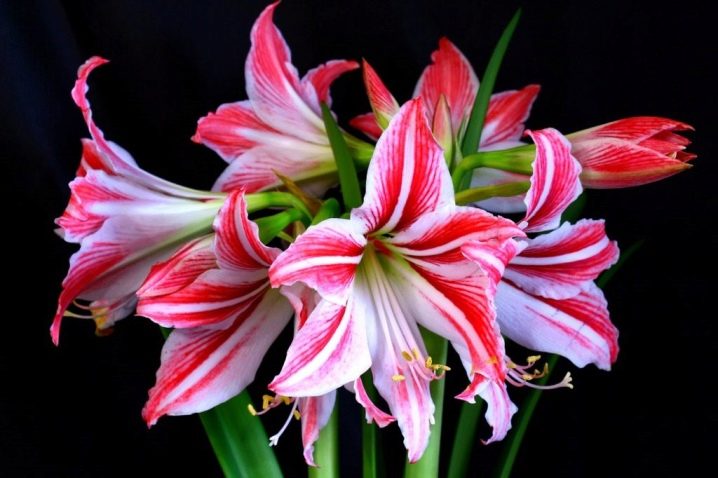
Description
Hippeastrum belongs to the category of flowering perennials of the bulbous type. Its bulbs can be both round and oblong, and sometimes even conical. The leaves are characterized by a linear shape and gloss. Their color, depending on the variety, can be light and bright green. The length of the foliage varies from 50 to 70 cm, the width does not exceed 5 cm on average. There is a shallow groove in the central part of the leaf. The leaves are located mainly in 2 rows. The hippeastrum peduncle, produced during the flowering period, is quite powerful, with an average height of 60–80 cm.
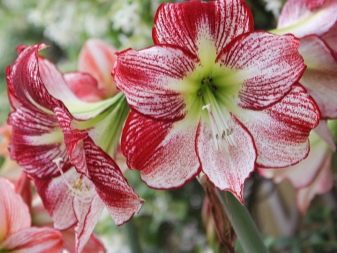

Hippeastrum is a home-grown hybrid mistakenly confused with amaryllis. However, the indoor flower, which is native to the tropics of America, has its own differences. For example, its bulb is covered with brownish-yellow scales. At the same time, it has fewer flowers in the inflorescence than amaryllis. As a rule, on average, there are no more than six of them on the peduncle, in rare cases - 9.
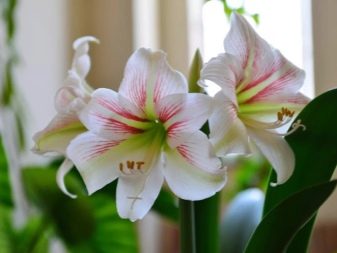
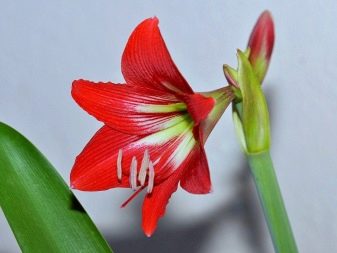
A distinctive feature of the plant is the hollow type of peduncle. In addition, depending on the type of variety, its foliage can be not only smooth, but also rough. As for flowering, this period in hippeastrum begins at the end of winter and does not last long, only until mid-spring. Hippeastrum flowers are large, showy and can have different colors. For example, in the shade palette there are colors such as white, pink, peach-orange, fiery, red-orange, cream. Some varieties are colored in two colors. You can find white hippeastrum with a thin red border along the terry edges.


Other varieties are decorated with several stripes of a contrasting color, located on the petals themselves. For example, the base color of a lily might be white, and the stripes on the petals might be red with a green center. The flowers of a creamy pink shade with a milky center are also incredibly beautiful. Lilies of red color with a white border are also very delicate. As for the filling of flowers, they can be very simple or terry. The petals curl back differently depending on the variety.
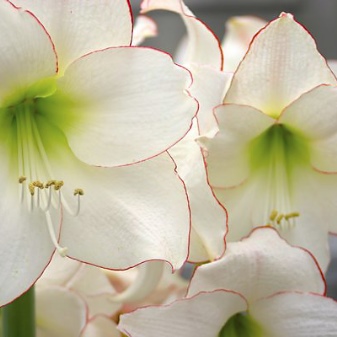
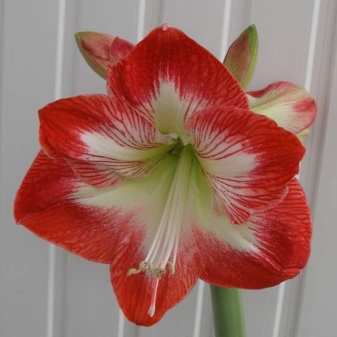
Some flowers seem to be needle-like and very simple, others are lush and elegant. As a rule, each flower blooms for no more than one and a half weeks, after which it fades.
Peculiarities
Having decided to start growing hippeastrum, you need to know its features. For example, growers note that varieties with white or light colors are distinguished by a small amount of germinating seeds. With proper care and comfortable conditions for the plant, hippeastrum can bloom twice per season. It is considered forcing, because, if desired, you can achieve that the flower blooms in a specific week.
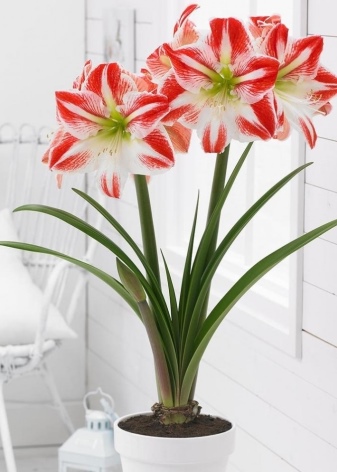
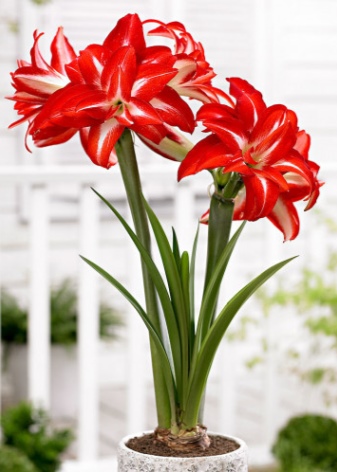
For example, to make flowers pleasing to the eye in October, you need to plant hippeastrum in late December - early January. If you want to decorate the room with flowers in January, they start planting in late February - early March. To drive out the peduncle by March, you need to plant the plant in April - early May.As for the biological time, depending on the variety, the plant itself blooms in late autumn or early spring.
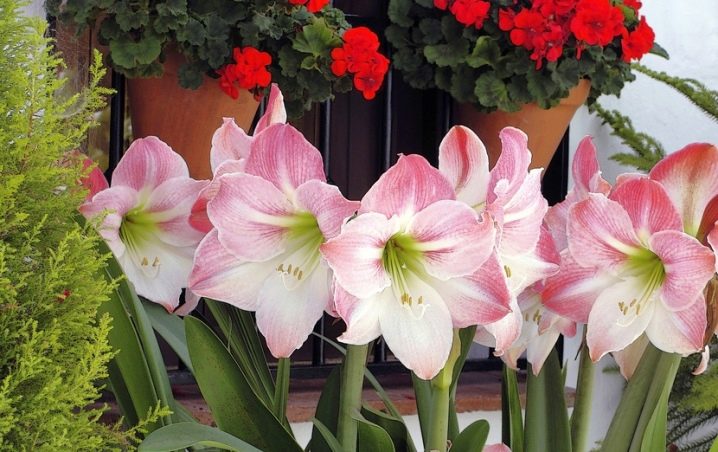
The plant is native to the tropics, and therefore requires a special climate for comfortable growth and development. It suffers without sun and needs the right moisture level. After flowering, it begins a dormant period, the duration of which can be 3-4 months. At this time, the hippeastrum can shed its leaves, which is why they first turn yellow and then dry out. All food collected during active growth and vegetation accumulates in the bulb, which grows in size during this time. However, it is very delicate and cannot withstand harsh treatment.
Therefore, transplants and other interventions must be approached correctly. For example, do not pick off dried leaves with your hands. They are cut with scissors only when they are completely dry.
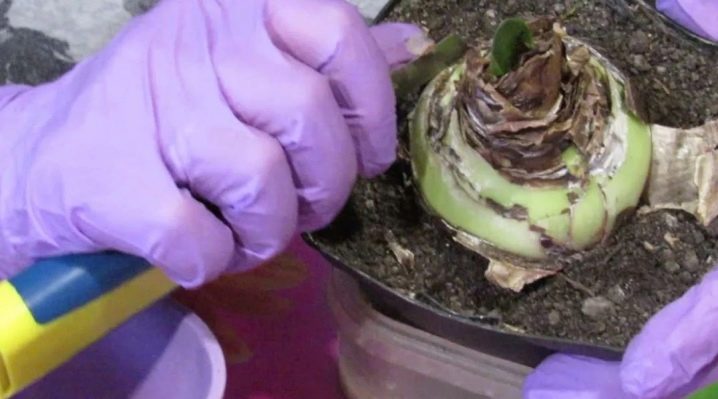
During rest, care must be taken to ensure that the soil in the pot with the bulb does not dry out. Of course, you can not often water a resting plant, as this is harmful; during the rest period, the volume of light and water should be reduced. But, given that the root system functions during hibernation, you need to take care of it. At the same time, it is important to choose the right temperature, which on average is + 6-12 degrees C.
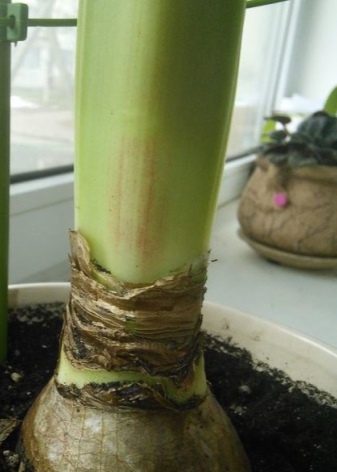
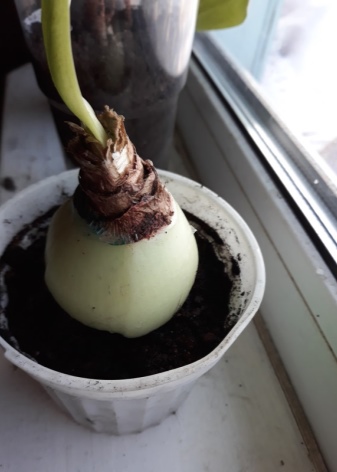
Types and varieties
Florists classify hippeastrum into two groups: ordinary and terry. In addition, the size and type of colors may vary. They can be small, miniature hybrid, orchid-like and long-tubular. For example, hippeastrum “Minerva” is an incredibly beautiful variety. We note a few more popular indoor varieties that can decorate any home.
- "Lady Jane" it is distinguished by the large size of double flowers and their peach color. On average, the diameter of the flowers is 18–20 cm. The edge of the flowers is corrugated, the petals are distinguished by the presence of reddish stripes. The middle of the flowers is pale green.

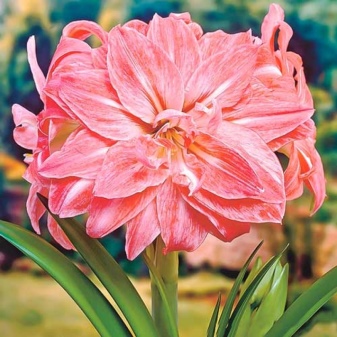
- "Leopolda" - a flower common among flower growers with a red color and a white border. The petals are decorated with wide white stripes, the middle of each flower is greenish-yellow.

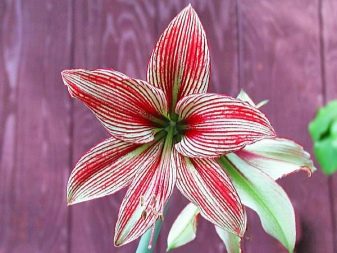
- Spotted variety differs in small height and laconic form of flowers. If in other varieties the flower consists of two rows of three wide petals, then here the petals do not overlap. The color of flowers consists of red dots, the middle is bright, light green.
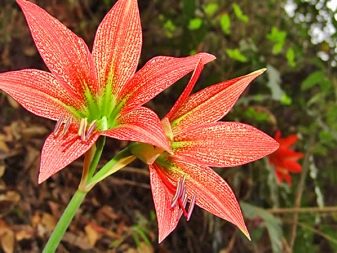
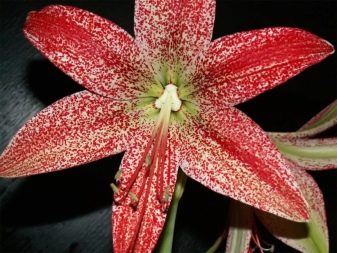
- Variety "Regina" or royal is distinguished by a half-meter height of a peduncle and a small size of purple-red flowers. Its leaves appear after flowering. The variety differs in the number of flowers: rarely when the peduncle has 4 flowers.
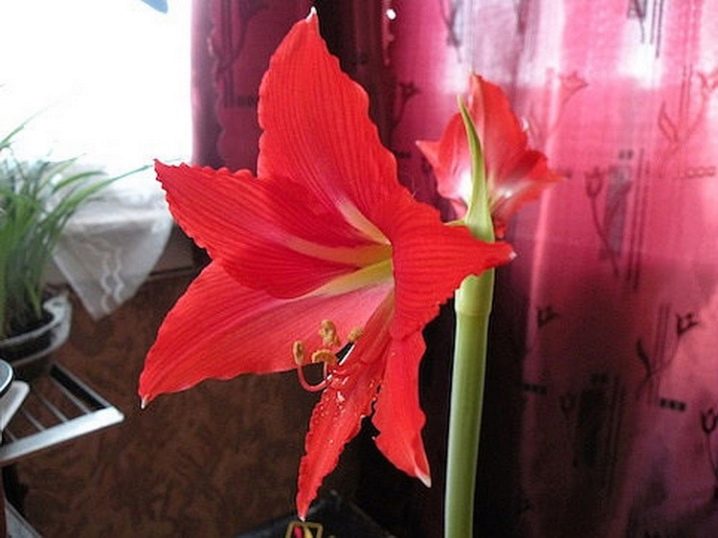
- Narrow-leaved variety it stands out among other varieties in the form of reddish-orange flowers: together they seem to be a single flower, each individually has a needle-like shape. One peduncle can contain up to 9 flowers.
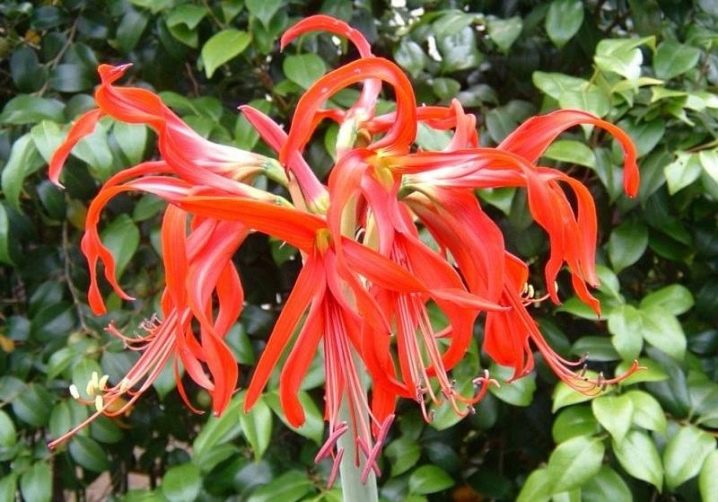
- Like flower growers and hippeastrum parrot... It is distinguished by an unusual color with a central star of bright green color and petals painted at the ends in a shade of red and white with red stripes. The peduncle of the plant is quite high - up to 90 cm. The number of buds usually does not exceed four.
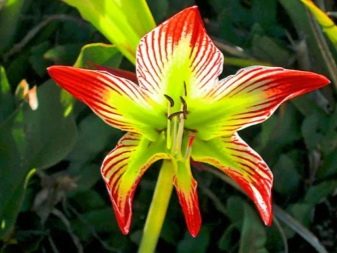
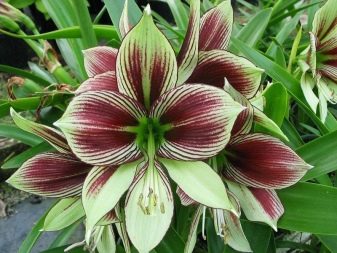
- Reticulated hippeastrum characterized by low growth, its peduncle rarely reaches half a meter. Flowers on it are usually tied no more than five. This variety is one of the most delicate, the color of the flower is pink stripes on a white background.

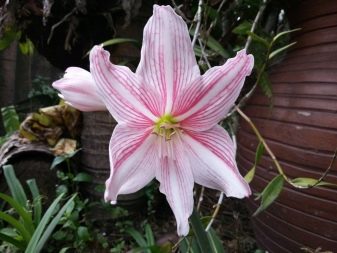
Landing rules
To grow a healthy and large plant that will delight you with bright flowering, you need to adhere to a number of rules that even experienced flower growers use. The correct choice of soil, container and planting material is important. The bulb is not completely buried; this is harmful to the plant.
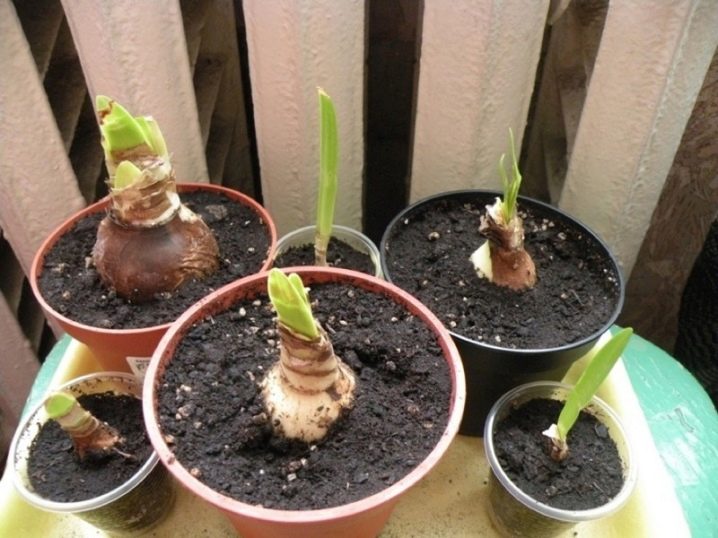
Planting material
For planting, you need to use an exceptionally healthy bulb. As a rule, there is no painful reddish border or red dots on the surface of such tubers.These factors indicate the defeat of the bulb with a fungal disease. If planting material is purchased in a specialized store, you should not take the first tubers that come across. Examine them: a quality bulb should be covered with brown scales. In addition, it must have living roots.

If you notice that dents or small grooves are visible on the surface of the planting material, then you should not take such a bulb, it is not suitable for growing a healthy plant. Also, it should not be too soft, dry and small.
If after planting 1.5 months have passed, and there are no leaves or sprouts, the bulb is considered unviable. Bulbs for planting must be prepared in advance (about 2 months before planting in the ground). They must be examined for the presence of fungal infections and rot. The onion husk should be shiny and the head itself should be hard. If, after lying at home before planting, the bulb gets sick, small lesions are removed by treating the cut sites with greenery. If it is practically all rotten, then it is not suitable for planting: you need to plant healthy planting material in the ground.

Soil and container
Hippeastrum does not like too spacious containers. The pot for it should be purchased based on the size of the purchased bulb. Ideally, it is chosen so that the distance from the edge of the bulb to the edge of the pot is no more than two to three centimeters. Considering that the flower grows tall and powerful, the pot must be firm and deep. At the same time, the bulb is planted in the ground only by half.

One of the key criteria for comfortable growth is the presence of drainage at the bottom of the pot. For it, expanded clay, chipped shards of small size or broken brick are used. Due to drainage, excess moisture will be removed, which will eliminate rotting of the bulb and root system. In order not to doubt the composition of the soil, you can go to a specialized store and buy a substrate for bulbous plants.
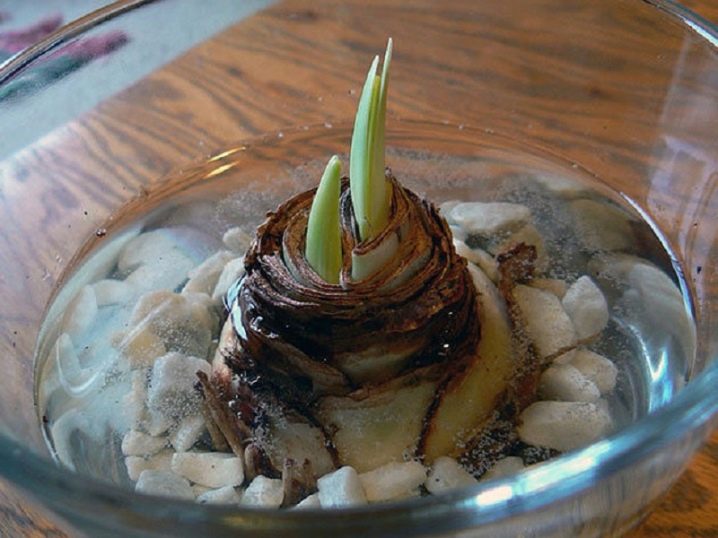
You can independently prepare a nutritious soil mixture from sod soil, humus, peat and river sand. You need to take the components in proportions of 2: 1: 1: 1. A little wood ash and bone meal can be included in the composition. If flour is not at hand, you can replace it with superphosphate in a ratio of 2 tsp. for 1 liter of soil.
Care features
Caring for the planted hippeastrum will consist in observing the rules of illumination, temperature, watering, timely feeding and reproduction. Let's briefly note the main nuances that everyone who wants to grow an exotic flower at home should know.
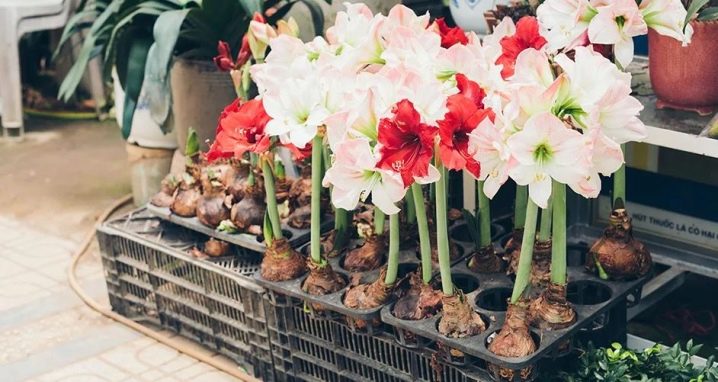
Illumination and humidity
Hippeastrum prefers to be caressed by the sun, but it cannot withstand its direct rays. Therefore, the place in the room for the pot must be selected in such a way that the light is diffused. The hot rays of the sun can burn foliage and flowers, which can injure the plant. A flower pot can be placed on the windowsill of a window that faces south, southeast or southwest. To maintain the compactness of the bush, the pot must be periodically rotated around its axis. If the plant has stood for some time in a shaded place, it should not be brought out abruptly to the light, especially if it is abundantly watered. Despite the fact that this speeds up the growth of the leaves, the development of the peduncle will slow down.

The plant tolerates temperate climates well. The room should not be allowed to dry. Humidify the air if necessary. You also need to monitor the condition of the leaves themselves: they must be promptly eliminated from settling dust using the soft side of a damp sponge.
Temperature regime
The optimal temperature for a flower is a mode with a range of + 17-25 degrees C. In summer, the plant feels comfortable on the windowsill of a balcony or loggia, it can be taken out on the veranda or in the gazebo. If the temperature is not suitable for the hippeastrum, this will affect the beauty of its flowers. When growing a flower at home, you need to know: for each period of development, as well as for rest, its own temperature is important.
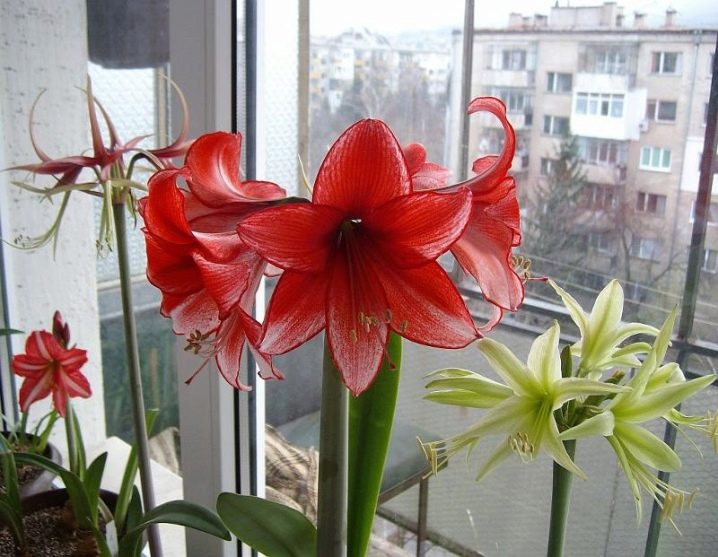
For example, when the hippeastrum is resting, a temperature of + 10-12 degrees is quite enough for it. When the first leaves appear, the room should be warm and comfortable. For example, it is good if during this period the temperature warms up to + 25-27 degrees. With active foliage growth, the temperature can be slightly lowered: juicy green leaves are formed when the room is not higher than +22 degrees C.

As for the growing season, it is important to consider here: if the temperature is more than +20 degrees C, this will accelerate the development of the peduncle. If it does not reach +18, then the peduncle will develop slowly. To prolong flowering, you can lower the temperature in the room to +18 degrees, if it is hot, the flowers will fade very quickly.
Watering
The watering regime for the hippeastrum must be regular and correct. Moreover, it is different depending on the development of the plant itself. For example, it is dosed in September, when the dormant period comes for the plant. It is reduced, and by the end of the month it is completely stopped if the flower is in a cool place. If it is left in a room where it is warm, you cannot do without moistening the soil. You need to take care of the plant in a timely manner, otherwise it will die.
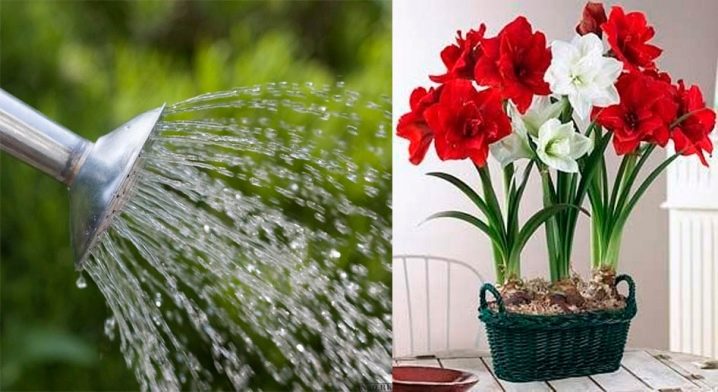
When the rest period is over, the hippeastrum is transferred to a warm place and the volume of water is gradually increased. At the same time, you need to water the plant not on the bulb itself, but in the pan or along the edges of the pot. If water gets in, the bulb can rot. However, you need to remember: constant soil moisture is better for a plant than overflow or lack of moisture. You cannot try to replenish it if you allowed the soil to dry out. The roots constantly draw water from the ground, when there is no moisture, the plant is deficient.

Water the hippeastrum with water at room temperature. Tap water must be defended or filtered to rid it of heavy metal salts and other harmful impurities.
Fertilization
Like any houseplant, hippeastrum needs regular feeding. Mineral fertilizers are well suited for this. At the very beginning of the growing season, you can feed the flower using top dressing for deciduous plants. You can feed it during flowering, starting from the period of bud formation on the peduncle, and ending with the moment when the flowers fade. For this, they take substances for flowering plants.
It is advisable to alternate feeding, using not only mineral, but also organic substances. You can feed it with nitrogen, potassium and phosphorus. As for the dormant period, no fertilizing is done at this time.

However, in addition to fertilizing, it must be borne in mind that over time the soil in the pot is depleted, and therefore, one way or another, the plant will have to be transplanted to a new place.
Preparing for hibernation
In preparation for hibernation, the plant may shed its foliage. At first, the leaves turn yellow, then gradually dry out. At this time, the main food will be concentrated in the bulb, and therefore it can swell and grow. It is undesirable to cut off the drying leaves on your own, since until they dry completely, the juices will not have time to pass into the bulb. Do not pick off dry leaves: they are cut with scissors or a sharp knife.
Do not forget about the plant for the entire dormant period: the root system, although slowly, is functioning. This means that you cannot do without soil moistening and certain lighting. You can not remove the resting hippeastrum in the darkness, you can not wake up the plant abruptly, bringing it out into the light and flavouring with abundant watering.
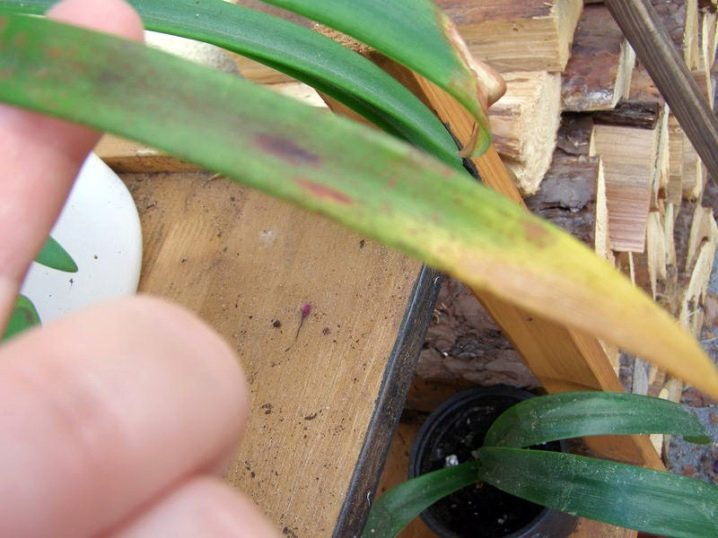
Reproduction
Hippeastrum reproduces by dividing the bulbs, "babies", scales and seeds. Each method has its own nuances.
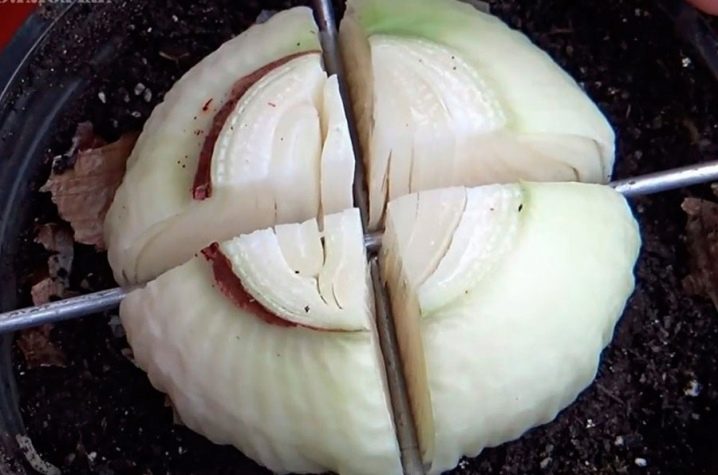
"Children" and seeds
The simplest and most effective way of breeding hippeastrum is to seat the "kids". They are carefully separated from the mother bulb, choosing specimens of at least 2 cm in diameter.This is done during the transplantation process, using a sterilized instrument to avoid contamination of the plant. Slices are sprinkled with crushed coal, after which the "kids" are planted in a pot with a prepared substrate. For two years, they try not to disturb the hippeastrum with transplants and foliage cutting.
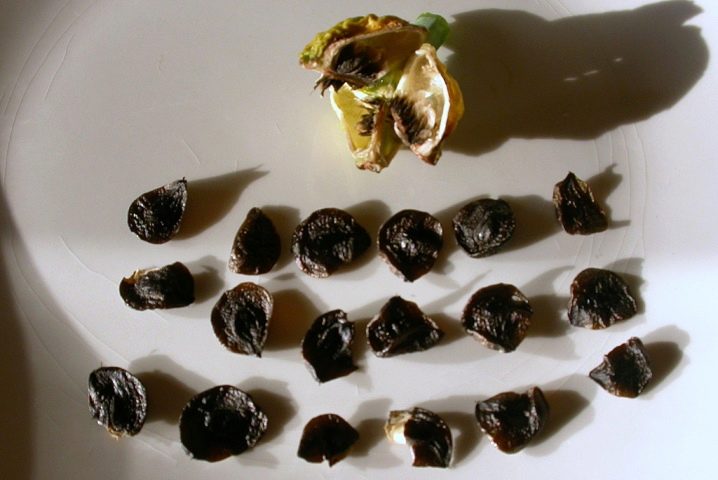
Reproduction by seeds is quite laborious, it is rarely resorted to, and the germination rate of seeds is no more than 30%. This method of cultivating a flower takes a lot of time and requires preliminary pollination of the hippeastrum to obtain seed.
By dividing the bulb
This method is used when the plant does not form "children". A bulb with roots and leaves is used as a planting material. They are cut, leaving no more than 2 cm in length, then the onion itself is cut into 2 or 4 parts using a sharp knife or a scalpel (previously disinfected to prevent decay). It is important that there is at least one root part on each cut part of the onion.

If there are no roots, it simply will not take root. You can not completely cut the onion, but cut it. Places of cuts should be treated with crushed activated carbon. After that, the cut tuber is removed to dry for two days. So that the slices do not touch each other and dry out faster, they are separated with chopsticks. It is necessary to partially immerse the planting material in the ground: you cannot completely cover the parts of the bulb with earth. Do not water them with water, spray them with a spray bottle. This growing technique is used in the fall, since it was at this time that the bulb was already saturated with useful substances that would increase the efficiency of reproduction.
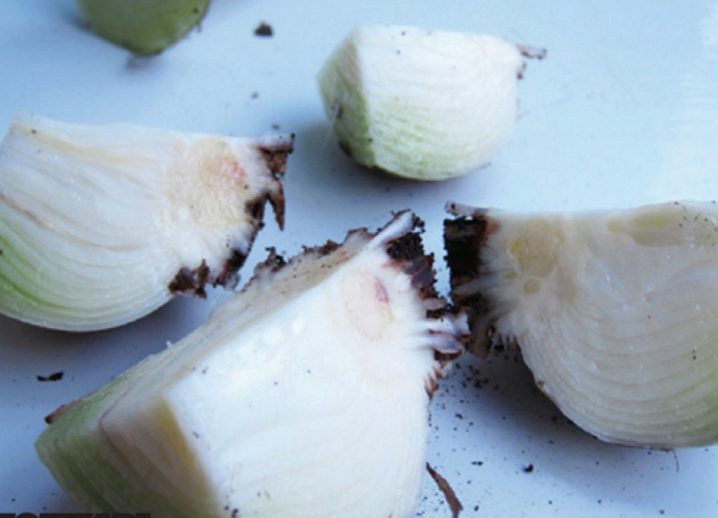
Onion with scales
In this method, the onion is cut into more parts. On average, their number can range from 8 to 16 pieces. It is important to cut it so that there is a bottom on each part. Slices with scales are treated with "Kornevin", after which they are planted in a prepared container in sand or sphagnum. The tops themselves are not closed, they should be on top. The containers are placed in a warm place for germination. A favorable temperature is +20 degrees C.

What else to consider?
As a rule, the plant produces two peduncles, but sometimes a third may appear during its development. In this case, you need to get rid of the released arrow as early as possible. If you leave it, it will be reflected in the size and number of colors. In addition, they may not be as bright as inherent in a particular variety. The plant itself is considered a long-liver. Depending on the variety, it can delight with flowers up to 20-25 years. At the same time, smooth and weighty bulbs with thick roots are better suited for planting. With proper care and the choice of good material, the plant can bloom not once, but twice a year. If there are no flowers for several years, this indicates poor nutrition of the plant and violation of the rules of care.
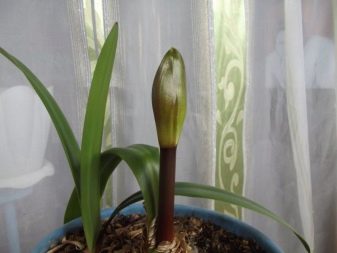
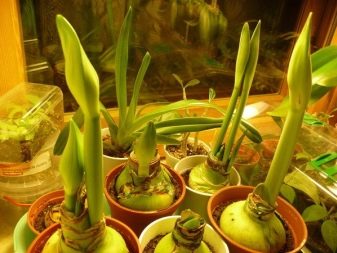
It is necessary to remove the hippeastrum from the ground and transplant it into new soil using a rooting agent and a growth stimulator. Over time, without top dressing, soil depletion occurs, which affects the growth and well-being of the flower. The transshipment is carried out in the spring, replanting the hippeastrum with the replacement of soil. A new pot is selected only when the size of the bulb increases (the more spacious the container, the less likely it will bloom).

Diseases and pests
When growing hippeastrum, you can face such troubles as peronosporosis disease, burn fungus and red rot. Also, the flower can be attacked by pests, including scale insects, aphids, spider mites and mealybugs. There are many ways to deal with pests. For example, you can carry out the treatment with an insecticide solution, having previously cleaned the parasites from the leaves.
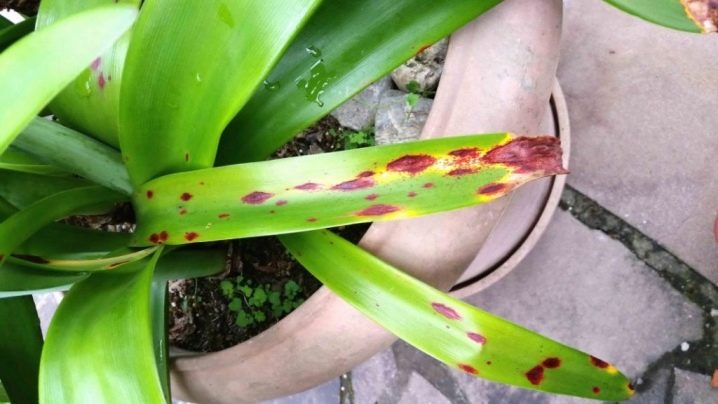
The sooner the cause of a plant disease is identified, the better, but for this you need to distinguish between symptoms. For example, the appearance of red spots on the bulb indicates a fungal burn.If a white coating appears on the surface of the soil, this is a clear sign of powdery mildew. The presence of rot is indicated by the hanging of the leaves and rotting of the scales of the bulb. Each case has its own solution. For example, if rot appears, you will have to get rid of all affected areas. All this is cut out, processed with "Fundazol", wood ash or crushed coal, after the bulb is dried. It will remain to be planted in a new substrate (preferably sterilized). Rot appears when water stagnates in the ground.
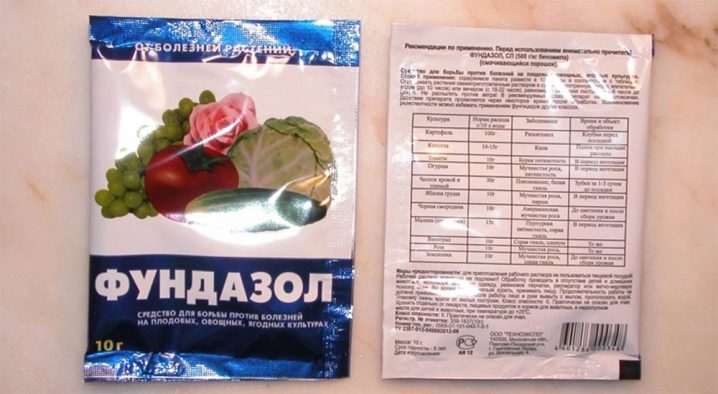
If it is revealed that the plant is affected by powdery mildew, it is treated with a special agent that is purchased at a flower shop. When the hippeastrum is damaged by a red burn, the bulb is removed from the ground, examined and removed from the infected areas. Places of cuts are treated with a mixture of copper sulfate and chalk in proportions of 1: 20, after which they are dried for about a week. After that, it is planted in fresh soil, treated with a fungicide.
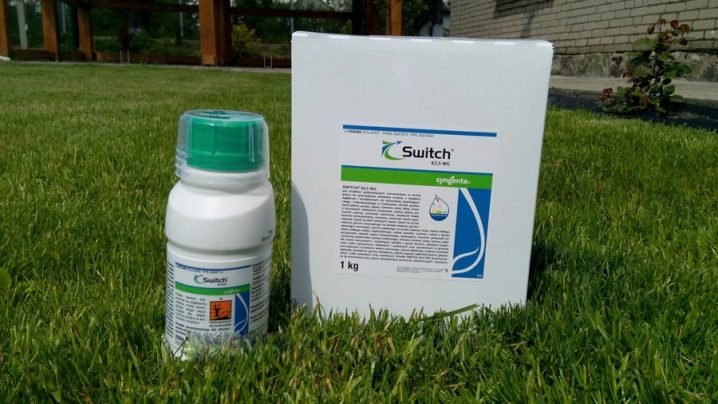
When growing, you can face other problems as well.
- Blanching leaves and lethargy of flowers talk about a lack of moisture in the soil, it is necessary to ensure that the earth does not dry out.
- Blackness of flowers indicates a low temperature in the room, you need to transfer the flower to a warmer place.
- Plant wilting may be due to excess moisture in the pot soil. It is necessary to revise the watering regime, reducing it taking into account the temperature and humidity in the room.
- Pallor of flowers can signal a sunburn, you need to move the pot away from the sun.
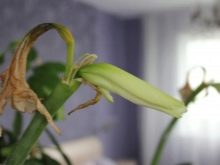

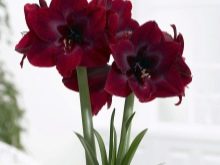
For information on how to properly care for hippeastrum, see the next video.




























The comment was sent successfully.